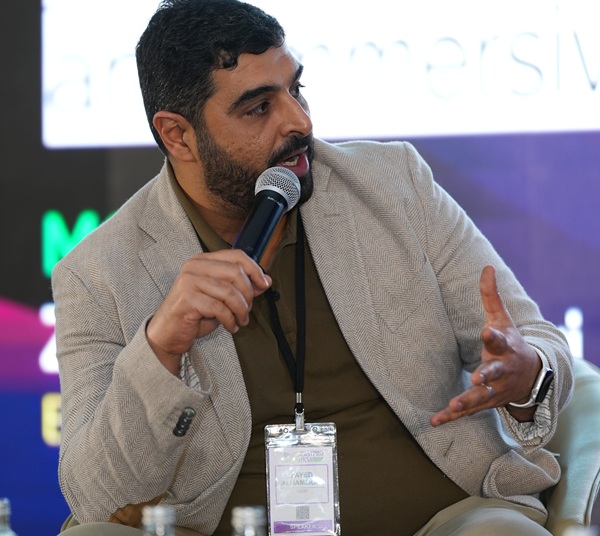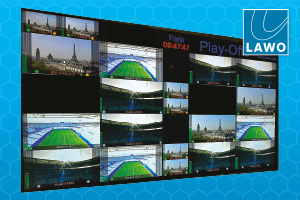At the BroadcastPro Summit KSA, the sports panel dived into the game-changing trends redefining sports broadcasting, from storytelling and remote production to automation, AI and fan personalisation. Here’s a closer look at the key takeaways.
Over the past decade, the Middle East has hosted several prestigious sporting events including the World Cup. Hosting these competitions required not only exceptional physical infrastructure but also drove the region’s sports broadcasters to adopt innovative techniques and cutting-edge technology for game telecasts across various formats.
The Sports panel, featuring Ammar Hina, Senior Broadcast and TV Production Director, Saudi Pro League (SPL); Faisal Alshadokhi, Live GFX Manager, Alamiya Media; and Jamal Abdulnaser Ali, Broadcast & Television Production Director, UAE Pro League (UPL), was moderated by Zayed Alhammori, Excellence Director MEA, Vizrt.

Kicking off the discussion, Zayed Alhammori made two observations: “Sport transcends borders, and behind every thrilling game is technology and passion. The Middle East is especially passionate about football.”
Fasial Alshadokhi credited the region’s audience as the driving force behind the popularity of sports broadcasting and innovation in broadcast technology. “In Saudi Arabia, the passion for football comes from the audience. They have been watching international football leagues such as La Liga and the Premier League for decades. They know the game and they’ve raised the bar very high for sports broadcasters. Our goal with the SPL is to have the highest standard when it comes to broadcasting. We work very closely with them to ensure that we meet the needs and passion of our audiences.”
SPL’s Ammar Hina concurred. “This is a very passionate part of the world for sports in general, and football in specific. Unfortunately, this isn’t known globally. I believe it’s time to show the world how passionate the region is about football. We need to show the world the real face of our fans. If we take the fans or audience as our main stakeholders and change the perspective from local to global, it changes the entire strategy of the broadcast. We’ve been working very closely with our partners to make the broadcast more international over the past few decades. There have been several challenges along the way, but I’m very proud to say that today SPL is ranked among the top five leagues worldwide.”

While making sports broadcasts globally appealing, preserving a unique game identity is just as crucial, noted UPL’s Jamal Abdulnaser Ali. “There is no point in trying to build an international presence without establishing a clear game identity. There has to be clear messaging in the content that we produce. The audience must be able to identify our brand or league just by watching the content. As a league, this is the strategy we must adopt to improve our output. If it’s missing, after a certain period you start losing followers.”
Beyond engaging fans, broadcasters also have to meet the expectations of other partners such as television rights holders and sponsors, he highlighted. “We have to be in line with the standards or requirements from each side. For instance, you have to ensure maximum visibility for commercial sponsors and high production quality for TV rights holders. Today’s football fans consume content from multiple leagues such as the Premier League, La Liga, SPL and UPL in a single day. They are constantly comparing, which makes it vital to match global standards.”
Technology is playing a massive role in meeting these varied requirements. Discussing how it has revolutionised game production, Alhammori asked the panellists to share their views on remote production and its benefits.

“Remote production is a new trend in the region. Saudi Arabia is a vast country with matches being played in several cities. Instead of deploying separate teams, we can now produce multiple matches in a day from one central location with remote production. It’s cost-effective, time-efficient and improves logistics,” said Alshadokhi.
The SPL is leveraging remote production for its international feeds, graphic overlays and English commentary, as well as for women’s competitions. It has conducted several proof-of-concepts over the past few months and plans to transition fully in due time.
Remote production can enhance connectivity too. “Currently we distribute on one or two signals only due to the limitations of broadcasting through satellite,” said Hina. “But if we have proper connectivity, then we can transmit and record feeds from several angles instead of recording everything on-premises. Better connectivity will enable us to reach more international markets as well, with more efficiency. This adds to the league’s content value, enhancing our sustainability. This is one of the challenges we are working on addressing currently, and we hope to make a breakthrough in the next couple of years.”
The UPL is also preparing to adopt remote production soon, confirmed Ali. “We are confident that remote production has the ability to improve not just the quality of production, but also game identity. We are working on implementing it in the UPL. There are a few challenges, but we are working to resolve them.”
The UPL recently made a huge technological leap with the use of vertical production for the Emaar Super Cup in December. Ali said: “Football is consumed by audiences of all ages, so we have to produce content that appeals to everyone. When we studied the market, we found that fans between the ages of 10 to 30 years – or maybe more – use social media platforms on their mobiles to watch the match. They prefer formats like reels and TikTok, which are all vertical. While we tested the technology in small ways in 2017 and 2018, we were able to make full-fledged use of it only last year. We used AI tools extensively to shoot the match in the vertical format and broadcast it on TikTok. It was a great experience and was very well received by the audience. I believe vertical production will become the future of many sports. In fact, it might even become a new category of rights. So soon we will have linear, digital and vertical rights.”

Audience preferences are undoubtedly shaping the content. Hina highlighted the “TikTok effect” as the latest trend that production companies now have to deal with. “Younger audiences prefer to consume content over a certain number of seconds. So our matches which are typically 90 minutes long, now have to be served in forms that meet these audience preferences. We have nearly five to six formats for each match which cater to the needs of various stakeholders such as news agencies and news outlets, TV channels, rights holders, social media platforms and influencers, and even the clubs and leagues themselves.”
He elaborated: “In the Middle East we also have 15-minute formats known as mini-matches. Broadcasters need these as an extra layer of content. These are extremely popular and there is constant demand for them. Instant highlights, such as fan reactions from the stadium, are also very popular and sometimes gain more attention than the full match.”
“In formats such as these, how critical is visualisation of a game?” asked Alhammori.
Alshadokhi said it was very critical and likened a match to a story. “We use graphics to build our story. For instance, in last year’s Riyadh Season Cup we used graphic overlays to give the audience a visual numeric representation of which team was performing better. This included details such as who’s had more passes, who’s had more control of the ball, how many times and for how long. Additionally, we deployed in-game realtime tracking for all the players. We used eight graphic systems, AI and sky cameras to produce real-time graphics for player movements, including details such as speed, distance covered and the number of passes. It is challenging to produce all of this in real time, but we succeeded in creating a truly immersive experience.”
Hina recalled the time he and Ali worked together to create a 360-degree immersive viewing experience. “It was the first worldwide full 90-minute football 360-degree experience. But after the numbers came in, we discovered that 99% of the audience were technology geeks; they had nothing to do with sport. Tools like these have a niche appeal and may help in acquiring special sponsors.”
AI is an exceptionally diverse tool and can be used in several ways. Alamiya Media is using it to enhance lighting effects and expedite the production of analysis clips and graphics.
“Lighting was a significant challenge for us. Different stadiums have different lights and this would impact the keying. Now we use AI to do the keying and it’s a very smooth process,” clarified Alshadokhi. “We’ve also been using AI to create the sports analysis clips and graphics. The production process is not just about capturing the minutes of play, but each event within a game. For this, the game graphics have to be generated rapidly in real time. Doing this manually is time-consuming, and by the time we complete it the game will have moved forward to the next event and we would have missed those. The director usually gives us a five-second window to display the graphics on screen. Thanks to AI, we are able to do this within two seconds in just a couple of clicks.”
He went on: “Generating sports analysis clips previously took nearly 10 minutes; AI has brought this down to two minutes. This has been a real game changer for us, especially for the studio analysis segments. These segments usually run for 60 minutes and the analysts want to discuss several clips. If it takes 10 minutes to produce each clip, the audience isn’t going to wait that long and the entire effort goes to waste.”
 The SPL also shares footage that rights holders could not air due to time constraints. “These usually contain extra angles that didn’t make it to the main broadcast output. Most of the trending moments on social media come from this footage,” said Hina. Additionally, the SPL uses AI to automate its clipping process for generating instant highlights.
The SPL also shares footage that rights holders could not air due to time constraints. “These usually contain extra angles that didn’t make it to the main broadcast output. Most of the trending moments on social media come from this footage,” said Hina. Additionally, the SPL uses AI to automate its clipping process for generating instant highlights.
However, Hina believes production companies cannot rely fully on AI to get the best output. “Sports broadcasts are full of drama, passion and moments that capture these emotions. Without human intervention, AI can’t identify these moments yet. For instance, if there were 35 passes before a goal was scored, AI would never trigger that. At the most, it will showcase about three or four passes just before that goal. It will capture the player celebrating the goal but may omit the players frustrated by that goal. So it misses the human part, and we may lose these emotional moments if we are to rely entirely on AI.”
The panel likened relying on AI to employing a production director who doesn’t understand the region’s language or the emotions and traditions surrounding the sport. “Even if you bring in the best operators or directors but they don’t have the right guidelines or standards, you won’t get the desired results. They will just not understand the pulse of the game and its people,” said Hina.
While most of the new technology in sports broadcasts caters to young audiences, the panellists noted that the viewing preference of mature viewers cannot be neglected. “These viewers still prefer traditional broadcast – a full 90-minute match without any extra effects. The overuse of AR and VR might put them off the viewing experience. Similarly, audiences in different countries have different preferences. So there is no one-size-fits-all approach. We have to keep customising the product depending on who is watching and from where,” said Hina.
All the panellists also agreed that content must be ‘glocal’ – global in nature but embellished with elements of local culture. Showcasing local talent is an important part of this effort. “Even when there are big names like Cristiano Ronaldo playing a match, you have to focus on the local talent,” said Hina. “If you keep focusing on just one player and this player leaves the league in the future, what then? There has to be a balance between all the players, local and international, and we have to work towards raising all of them. The game is not a product to serve only one fan segment.”
Although the panellists concurred that AI needs to be used judiciously, they felt confident about some areas where AI functions perfectly. Alshadokhi cited instances where AI works independent of human intervention to generate player stats and display them on the screen. This could include goal-scorers or players who get foul cards.
All the technology used in game production is simply a means to cater to the human emotion behind every match. Noting this, the panellists suggested that the next progression in the use of AI would be to enable fans to customise their own viewing experience. “We should be able to give audiences different viewing experiences where they can watch the game on a normal programming feed, or on a mobile app with the ability to see the match from different angles – almost like a second screen. In fact, we experimented with this five years ago. It was a great experience, but at that point, it was ahead of its time and not a viable option, as many didn’t want to pay for it,” said Alshadokhi.
While innovation is vital, the panellists highlighted that awareness campaigns are equally crucial. “No matter how advanced our technology gets, it won’t succeed unless audiences and rights holders understand its value. Education and engagement are key to driving adoption,” Alshadokhi concluded.















































































